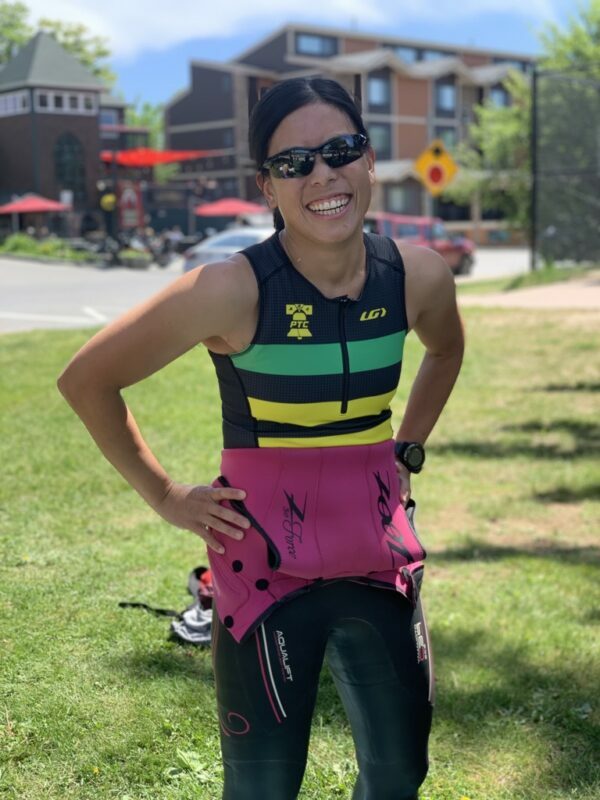Swimming is a low injury risk sport but swimmer’s aren’t injury free. Swimmer’s shoulder, or rotator cuff tendonitis, is the most common injury for swimmers. Unfortunately if you’ve been swimming long enough, it’s often not if you’ll get it, it’s when. 47% of collegiate swimmers and 48% of masters swimmers have experienced shoulder pain lasting 3 weeks or longer (https://pubmed.ncbi.nlm.nih.gov/7614080/).
Another study followed 80 elite swimmers aged 13-25, and 91% experienced shoulder pain. An MRI showed inflammation in 69% of the swimmers in the tendon of the supraspinatus muscle. I spent the better part of my 2021 season recovering from this type of tendonitis. So, in this article, I will share what I’ve done to help you prevent or rehab this issue.
What causes swimmer’s shoulder?
1. Shoulder fatigue – overuse or increasing swimming too much too soon can cause inflammation in the shoulder tendons.
2. Muscular imbalance – this is something a good PT will address but you can also do some assessments yourself, seeing if your internal rotation is as strong as external rotation, and if your right arm is as strong and flexible as your left arm.
3. Poor technique – Crossing over the midline of the body in freestyle is the most common offender of causing shoulder impingement, but sculling out too wide in the catch along with index finger/thumb-first hand entry (with palm facing out) can also both cause impingement over time. If you do not have a coach on deck to correct form, video yourself and see if this is an issue.
4. Poor posture – this was something I wasn’t conscious I was doing. I work off a small laptop and spend hours per day hunched over it. The PT caught me sitting in a slouched position during one of my appointments and I had no idea my posture was this bad. I’ve since tried correcting myself and bought a laptop stand so that I sit up straighter with my scapula engaged as I work. Once you start correcting it in your everyday life, it will hopefully carry over to the pool so you’re swimming with better posture.

Prevent or Treat Swimmer’s Shoulder
1. Swim with excellent technique
This is the primary cause of shoulder impingement. Repeating bad technique over and over will cause injury. See my previous article on drills to help correct swim form mistakes. Avoid drills that over emphasize high elbow recovery and shrugging the shoulder (such as zipper drill), which can cause impingement. Be careful how much you’re using both a kick board and paddles, both of which can place stress on the shoulders. Choose paddles that are just slightly larger than your hands and ease into how much you use them.
2. Physical Therapy
If you’ve been dealing with shoulder pain for more than a few weeks, and rest isn’t fixing it, it’s time to get checked out by a PT who knows shoulders and athletes. You may only need to do a few sessions to get the prognosis and exercises to address weakness and imbalances around the shoulder joint.
3. Sleep position
How many times have you woken up with a stiff or sore shoulder? Your sleep position matters for how much stress we put on our shoulders. Sleeping on your side or belly with your arm overhead or underneath you can place the shoulder out of alignment and cause pain. Sleep on your back when possible.
4. Improve mobility in both your shoulders and thoracic spine.
Sleeper stretch is one of my favorite shoulder stretches, and it’s important that both shoulders are equally as flexible. See the image below.
5. Improve scapular stability
Increased scapular strength and stability set you up for increased power in the shoulders and less chance of injury. Engage your scapula by shrugging the shoulder blades back and down, making them disappear as best you can. Keep them engaged with any upper body strength movement, and throughout your day when you’re standing and sitting.
6. Strengthen rotator cuffs
Most of us already know about internal and external band rotations, which are great. But you can also strengthen the rotator cuffs with standing rows, 90 degree external rotations (holding elbow up at shoulder height), scapular push ups, and many more. These can be good warm up exercises to mix up before strength or swim sessions.
Consider a video analysis with us to identify issues with form. We can include a report with your analysis that includes drills to incorporate in any swim.
7. Focus on what you CAN do while you’re healing.
Do workouts that are 100% kick, and vary it up with kicking on side, back, doing different stroke’s kicks, and kicking with fins. Limit the use of a kick board by purchasing a snorkel. I had to do this for months while my stubborn shoulder was healing.
8. Ease back in.
Once your shoulder gets a little better, you can ease back into swimming with fins to take some pressure off the shoulder, and alternate kick and swim intervals. Slowly increase the amount of swimming each week. Stay patient and positive.
Ready to get your stroke analyzed to prevent or recover from shoulder pain?
Let one of our experienced coaches provide a detailed swim video analysis to identify and correct technique issues before they lead to injury.
Contact us to schedule your swim analysis today and take a proactive step toward pain-free, efficient swimming!
References:
https://bjsm.bmj.com/content/44/2/105.abstract
https://pubmed.ncbi.nlm.nih.gov/7614080/
https://www.yourswimlog.com/how-to-fix-and-prevent-swimmers-shoulder/
